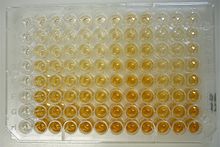ELISA
![]()
ELISA is a redirect to this article. For other meanings of "ELISA", see Elisa.
Enzyme-linked immunosorbent assay (ELISA) refers to an antibody-based detection method (assay). Like the radioimmunoassay (RIA), the ELISA also belongs to the group of immunoassay methods, but is not based on a radioactivity measurement but on an enzymatic colour reaction and thus belongs to the enzymatic immunoadsorption methods (EIA). The antigen to be detected was originally adsorptively bound to a microtiter plate via an initial antibody and enriched, an enzyme-coupled second antibody (synonym: detection antibody) led to the reaction of a dye substrate.
With the aid of ELISA, proteins (e.g. antibodies) and viruses, but also low-molecular compounds such as hormones, toxins and pesticides can be detected in a sample (blood serum, milk, urine, etc.). This is done by using the property of specific antibodies that bind to the substance (antigen) to be detected. An antibody is previously labelled with an enzyme. The reaction catalyzed by the reporter enzyme serves as evidence for the presence of the antigen. The so-called substrate is converted by the enzyme, the reaction product can usually be detected by color change, possibly also by chemiluminescence. The signal strength is a function of the antigen concentration that can be determined very precisely with a photometer, so that ELISA can also be used for quantitative detection when performed as multiple measurements. The most commonly used reporter enzymes are horseradish peroxidase (HRP), alkaline phosphatase (AP) or, more rarely, glucose oxidase (GOD). In the case of alkaline phosphatase, e.g. p-nitrophenyl phosphate (pNPP) is added as a dye substrate (synonym: chromogen), while o-phenylenediamine (oPD) is usually used for peroxidase. The alkaline phosphatase cleaves the phosphate residue from the colorless nitrophenyl phosphate to give p-nitrophenol, which is faint yellow. The change in concentration of the dye formed by the enzymatic reaction can be followed with a photometer according to Lambert-Beer's law. The intensity of the colour increases with the concentration of the nitrophenol formed and thus also the concentration of the antigen to be determined in the sample in comparison with a dilution series with known concentrations (standard series).

Different variants of the ELISA

Typical ELISA ("Anti human IgG" Double Antibody Sandwich)
History
The precursor of the ELISA was the radioimmunoassay since 1960. For an enzymatic detection, the direct coupling of proteins was necessary so that the reporter signal also only appears coupled with the specifically binding antibody. Chemical coupling of proteins was developed simultaneously by Stratis Avrameas and G. B. Pierce. The adsorption of proteins on surfaces had already been studied by Jerker Porath in 1966. The ELISA was developed simultaneously in 1971 by two research groups, including Peter Perlmann and Eva Engvall in Sweden.
Signal amplification
Instead of an enzyme-coupled detection antibody, the combination of an uncoupled detection antibody and an additional (third) secondary antibody (secondary because it is an antibody against antibody), to which an enzyme has been bound, can also be used for signal amplification (see Fig.). This requires another incubation and washing step. The buffer used is usually TBS-T buffer. Although more laborious, the use of a secondary antibody conjugate has the advantage that the costly production of many different enzyme-linked primary antibodies specific for only one antigen each can be circumvented. The secondary enzyme-linked antibodies used, which are polyclonal antibodies that can bind simultaneously to different epitopes in the constant region (Fc region) of all the primary antibodies of a species, can be used more widely and lead to signal amplification. In addition, secondary antibody-enzyme conjugates can be used for a variety of different immunoassays due to specificity for Fc regions of an antibody subtype from a species, making the secondary antibody a more cost-effective industrial mass-produced product. Further common signal amplification can be achieved by binding streptavidin or avidin conjugates to biotinylated detection antibodies in the final incubation step. Detection with (strept-)avidin-enzyme conjugates also result in signal amplification due to multiple biotinylations of the primary antibodies and the consequent binding of multiple reporter molecules.
Modern reporter systems partly allow higher sensitivities (e.g. immuno-PCR) or parallel determinations in one approach (multiplex) by using fluorescence or the polymerase chain reaction, but are not ELISAs in the strict sense.
Questions and Answers
Q: What is ELISA?
A: ELISA stands for Enzyme Linked Immuno-Sorbent Assay, which is a technique used in biochemistry to detect the presence of a specific substance within a sample.
Q: How does ELISA work?
A: ELISA uses antibodies that attach themselves to the substance being tested, generating a specific color that indicates the amount of the substance present.
Q: What kind of substances can ELISA detect?
A: ELISA can detect specific cytokines or antigens within a sample.
Q: What does the amount of color generated by ELISA indicate?
A: The amount of color generated by ELISA indicates the amount of the substance being tested present in the sample.
Q: Is ELISA the only technique used to detect specific substances within a sample?
A: No, there is a more sophisticated and sensitive technique called the ELISPOT method derived from the ELISA technique.
Q: What is the role of the second set of antibodies used in ELISA?
A: The second set of antibodies in ELISA is used to capture the substance being tested, adhering to both the substance and the testing container to hold the substance in place.
Q: Does ELISA always generate color when a substance is detected?
A: Not always, sometimes the substance must be viewed under ultraviolet light for the antibodies to generate the color.
Search within the encyclopedia